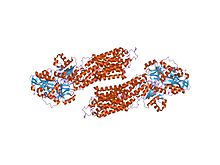User:Cboursnell/Sandbox2
| Cation_ATPase_C | |||||||||
|---|---|---|---|---|---|---|---|---|---|
 crystal structure of the sr ca2+-atpase with bound amppcp | |||||||||
| Identifiers | |||||||||
| Symbol | Cation_ATPase_C | ||||||||
| Pfam | PF00689 | ||||||||
| InterPro | IPR006068 | ||||||||
| SCOP2 | 1eul / SCOPe / SUPFAM | ||||||||
| TCDB | 3.A.3 | ||||||||
| |||||||||
ATPases (or ATP synthases) are membrane-bound enzyme complexes/ion transporters that combine ATP synthesis and/or hydrolysis with the transport of protons across a membrane. ATPases can harness the energy from a proton gradient, using the flux of ions across the membrane via the ATPase proton channel to drive the synthesis of ATP. Some ATPases work in reverse, using the energy from the hydrolysis of ATP to create a proton gradient. There are different types of ATPases, which can differ in function (ATP synthesis and/or hydrolysis), structure (F-, V- and A-ATPases contain rotary motors) and in the type of ions they transport.[1][2]
- F-ATPases (F1F0-ATPases) in mitochondria, chloroplasts and bacterial plasma membranes are the prime producers of ATP, using the proton gradient generated by oxidative phosphorylation (mitochondria) or photosynthesis (chloroplasts).
- V-ATPases (V1V0-ATPases) are primarily found in eukaryotic vacuoles, catalysing ATP hydrolysis to transport solutes and lower pH in organelles.
- A-ATPases (A1A0-ATPases) are found in Archaea and function like F-ATPases.
- P-ATPases (E1E2-ATPases) are found in bacteria and in eukaryotic plasma membranes and organelles, and function to transport a variety of different ions across membranes.
- E-ATPases are cell-surface enzymes that hydrolyse a range of NTPs, including extracellular ATP. P-ATPases (sometime known as E1-E2 ATPases) (EC) are found in bacteria and in a number of eukaryotic plasma membranes and organelles.[3] P-ATPases function to transport a variety of different compounds, including ions and phospholipids, across a membrane using ATP hydrolysis for energy. There are many different classes of P-ATPases, each of which transports a specific type of ion: H+, Na+, K+, Mg2+, Ca2+, Ag+ and Ag2+, Zn2+, Co2+, Pb2+, Ni2+, Cd2+, Cu+ and Cu2+. P-ATPases can be composed of one or two polypeptides, and can usually assume two main conformations called E1 and E2.
This entry represents the conserved C-terminal region found in several classes of cation-transporting P-type ATPases, including those that transport H+ (EC), Na+ (EC), Ca2+ (EC), Na+/K+ (EC), and H+/K+ (EC). In the H+/K+- and Na+/K+-exchange P-ATPases, this domain is found in the catalytic alpha chain.
More information about this protein can be found at Protein of the Month: ATP Synthases .
References
[edit]- ^ Cross RL, Müller V (October 2004). "The evolution of A-, F-, and V-type ATP synthases and ATPases: reversals in function and changes in the H+/ATP coupling ratio". FEBS Lett. 576 (1–2): 1–4. doi:10.1016/j.febslet.2004.08.065. PMID 15473999.
{{cite journal}}: CS1 maint: date and year (link) - ^ Rappas M, Niwa H, Zhang X (April 2004). "Mechanisms of ATPases--a multi-disciplinary approach". Curr. Protein Pept. Sci. 5 (2): 89–105. doi:10.2174/1389203043486874. PMID 15078220.
{{cite journal}}: CS1 maint: date and year (link) CS1 maint: multiple names: authors list (link) - ^ Axelsen KB, Palmgren MG (January 1998). "Evolution of substrate specificities in the P-type ATPase superfamily". J. Mol. Evol. 46 (1): 84–101. doi:10.1007/pl00006286. PMID 9419228.
{{cite journal}}: CS1 maint: date and year (link)
